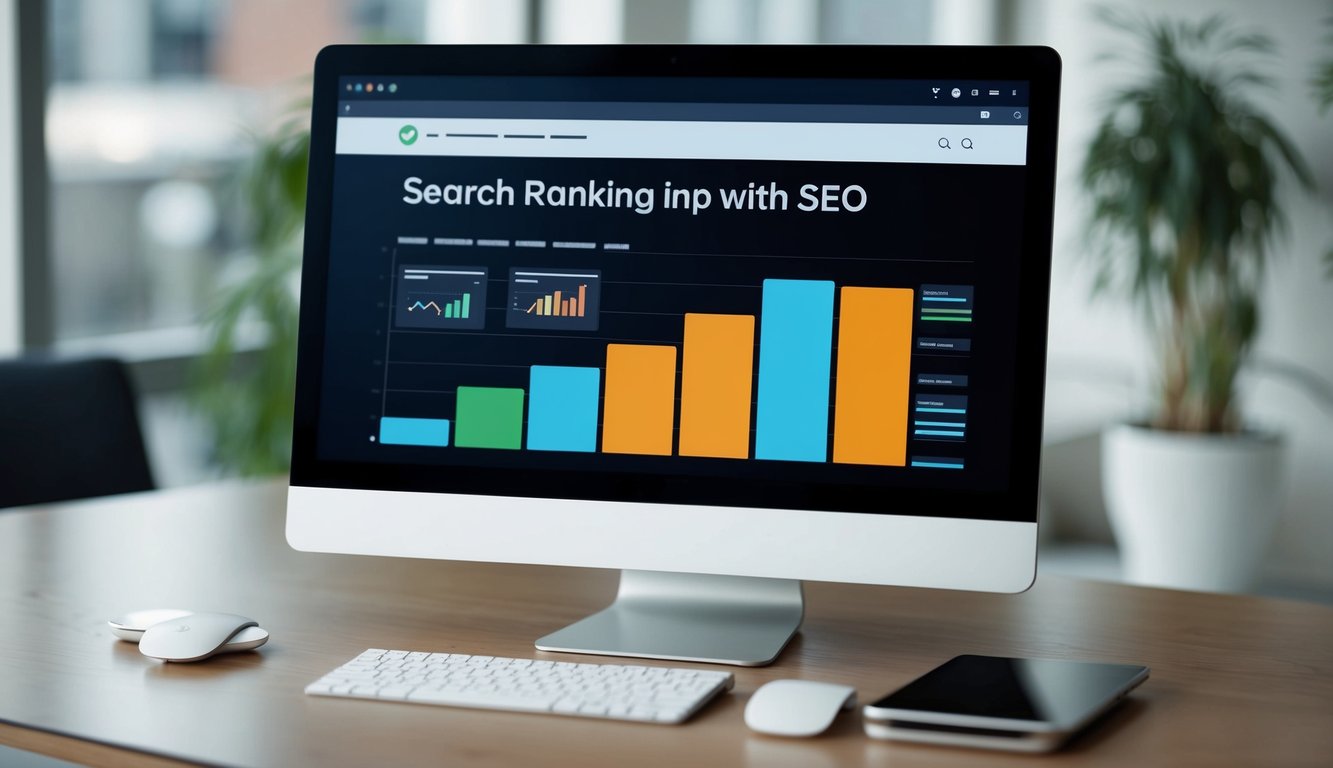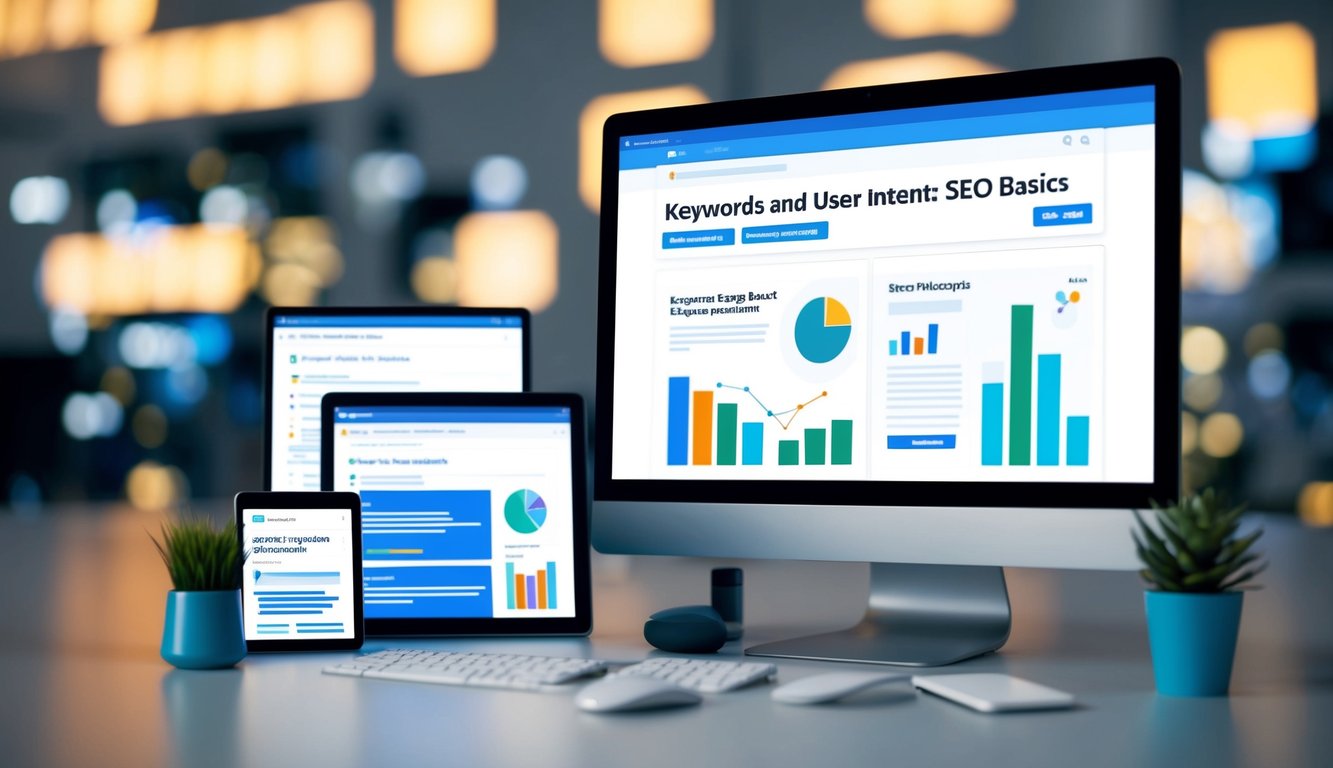Effective SEO Strategies: Strategies for Your Website’s Visibility

Search Engine Optimization (SEO) is a vital component of digital marketing that can significantly impact your website’s visibility and success. By understanding and implementing SEO basics, you can improve your site’s ranking on search engine results pages, driving more organic traffic to your content. Effective SEO strategies involve optimizing your website’s structure, content, and backlink profile to align with search engine algorithms and user intent.

SEO is not just about pleasing search engines; it’s about creating a better user experience for your visitors. When you focus on SEO fundamentals, you’re essentially fine-tuning your website to provide valuable, relevant content that answers users’ questions and solves their problems. This approach not only helps you rank higher but also builds trust and credibility with your audience.
As you delve into the world of SEO, you’ll discover that it’s an ever-evolving field. Search engines like Google constantly update their algorithms, which means staying informed about SEO basics is crucial for maintaining and improving your website’s performance. By mastering these fundamentals, you’ll be well-equipped to adapt to changes and keep your site competitive in the digital landscape.
Key Takeaways
- Optimize your website’s structure and content to improve search engine rankings and user experience
- Conduct thorough keyword research to align your content with user intent and search queries
- Regularly analyze and measure your SEO efforts to refine strategies and achieve better results
Understanding SEO and Its Importance

SEO and effective SEO strategies plays a crucial role in improving your website’s visibility and attracting potential customers. It involves optimizing your content to rank higher in search engine results, leading to increased organic traffic and better online performance.
What is SEO?
Search engine optimization (SEO) is a set of practices designed to enhance your website’s visibility in organic search results. It focuses on improving your site’s content, structure, and performance to make it more attractive to search engines.
SEO involves several key elements:
- Keyword research and optimization
- Creating high-quality, relevant content
- Improving site speed and user experience
- Building quality backlinks
By implementing these strategies, you can increase your chances of ranking higher in search results and attracting more visitors to your site.
Evolution of Search Engines
Search engines have come a long way since their inception. Early search engines relied on simple keyword matching, often leading to irrelevant results.
Today’s search engines use complex algorithms to determine relevance and quality. They consider factors like:
- Content relevance and quality
- User experience and site performance
- Mobile-friendliness
- Domain authority and backlink profile
These advancements have made it more challenging but also more rewarding to optimize your site for search engines.
Why SEO Matters for Your Website
SEO is crucial for your online success. It helps you:
- Increase visibility: Higher rankings mean more people see your website.
- Drive organic traffic: SEO brings in free, targeted traffic from search engines.
- Build credibility: Top-ranking sites are often perceived as more trustworthy.
- Improve user experience: SEO practices often align with creating a better site for users.
By investing in SEO, you can attract more potential customers and grow your online presence. It’s a long-term strategy that can provide sustainable results and help you stay competitive in the digital landscape.
Keywords and User Intent

Keywords and user intent are foundational elements of effective SEO strategies. Understanding how to research keywords and align them with searcher goals is crucial for optimizing content and improving rankings.
Fundamentals of Keyword Research
Keyword research forms the backbone of SEO strategy. You’ll want to start by identifying relevant terms and phrases your target audience uses when searching for information related to your business or content. Tools like Google Keyword Planner can help you discover keyword ideas and their search volumes.
Focus on long-tail keywords – specific phrases with lower competition but higher conversion potential. Consider search volume, competition, and relevance when selecting keywords. Prioritize terms that align with your content and business goals.
Create a list of primary and secondary keywords to target. Group related keywords into clusters to inform your content strategy.
Analyzing Search Intent
Understanding user intent is crucial for SEO success. Search intent refers to the goal behind a user’s query. You can categorize intent into four main types:
- Informational: Users seeking information or answers
- Navigational: Users looking for a specific website or page
- Commercial: Users researching products or services
- Transactional: Users ready to make a purchase
Analyze search engine results pages (SERPs) for your target keywords to identify the dominant intent. Look at the types of content ranking well and adjust your strategy accordingly.
Optimizing for Relevance and Context
To optimize your content for both keywords and user intent, focus on relevance and context. Craft high-quality content that addresses the specific needs and questions of your target audience.
Use your chosen keywords naturally throughout your content, including in titles, headings, and meta descriptions. Avoid keyword stuffing, as it can harm your SEO efforts.
Incorporate semantic keywords and related terms to provide context and depth to your content. This helps search engines better understand your topic and improves your chances of ranking for relevant queries.
Consider your audience’s needs at different stages of their journey. Create content that caters to various intents, from informational to transactional, to capture users at different points in their decision-making process.
Technical Aspects of SEO and Effective SEO Strategies

Technical SEO Basics forms the foundation of a well-optimized website and the right seo strategies. It encompasses crucial elements that help search engines crawl, index, and understand your site’s content effectively.
Website Structure and Design
A well-structured website is essential for both users and search engines. Organize your content hierarchically, using a logical site architecture. Implement a clear navigation menu and include internal links to help visitors and search engines discover important pages.
Create an XML sitemap to guide search engines through your site’s structure. Submit this sitemap to Google Search Console to improve crawling efficiency.
Use header tags (H1, H2, H3) to structure your content and help search engines understand the hierarchy of information. Implement structured data to provide context about your content, enhancing how it appears in search results.
Optimize your page speed by compressing images, minifying CSS and JavaScript, and leveraging browser caching. Fast-loading pages improve user experience and are favored by search engines.
The Role of URLs and Domains
Choose a domain name that reflects your brand and is easy to remember. Opt for a .com extension when possible, as it’s widely recognized and trusted.
Create clean, descriptive URLs that include relevant keywords. Use hyphens to separate words and keep URLs concise. For example:
- Good: yourdomain.com/blue-widgets
- Avoid: yourdomain.com/page1?id=123
Implement proper URL redirects (301 for permanent, 302 for temporary) when changing page locations. This preserves link equity and ensures users find the correct content.
Use canonical tags to indicate the preferred version of a page when multiple similar versions exist. This helps prevent duplicate content issues.
Ensuring Mobile-Friendliness and Crawling
With mobile-first indexing, it’s crucial to have a responsive website design that adapts to various screen sizes. Test your site’s mobile-friendliness using Google’s Mobile-Friendly Test tool.
Optimize your mobile site’s loading speed by using AMP (Accelerated Mobile Pages) for content-heavy pages. This can improve user experience and potentially boost your search rankings.
Use your robots.txt file to guide search engine crawlers. Indicate which parts of your site should be crawled and which should be ignored. Be cautious not to accidentally block important content.
Monitor your site’s crawl budget through Google Search Console. Identify and fix crawl errors promptly to ensure all your important pages are indexed.
Implement SSL encryption (HTTPS) to secure your website. This not only protects user data but is also a ranking factor in Google’s algorithm.
On-Page SEO Best Practices

On-page SEO involves optimizing individual web pages to rank higher in search results. It focuses on content quality, strategic keyword placement, and user experience enhancements.
Creating Compelling Content
Quality content is the foundation of successful on-page SEO. Start by identifying your target keywords through thorough research. Incorporate these keywords naturally throughout your text, maintaining a density of 1-2%.
Aim for content that is informative, engaging, and valuable to your audience. Break up large blocks of text with subheadings, bullet points, and images to improve readability.
Use internal links to connect related content on your site, helping both users and search engines navigate your pages effectively. Regularly update your content to keep it fresh and relevant.
Optimizing Title Tags and Headings
Your title tag is crucial for both SEO and user engagement. Craft compelling titles that include your primary keyword near the beginning. Keep titles under 60 characters to ensure they display fully in search results.
Structure your content with clear, descriptive headings (H1, H2, H3). Include relevant keywords in these headings, but prioritize clarity and user understanding.
- H1: Use only one per page, typically matching your title tag
- H2-H6: Organize content hierarchically, making it easy to scan
- Include keywords naturally, avoiding over-optimization
Leveraging Meta Descriptions
While meta descriptions don’t directly impact rankings, they can significantly affect click-through rates. Write concise, compelling descriptions of 150-160 characters that accurately summarize your page content.
Include your primary keyword and a clear call-to-action to encourage clicks. Tailor each meta description to its specific page, avoiding duplicate content across your site.
Optimize your meta descriptions for user intent, addressing what searchers are looking for when they encounter your page in search results. Use action-oriented language to entice users to click through to your site.
Off-Page SEO Strategies
Off-page SEO involves actions taken outside your website to improve its search engine rankings. These strategies focus on building your site’s authority and credibility through external signals.
The Power of Backlinks
Backlinks are crucial for off-page SEO success. High-quality links from reputable websites act as votes of confidence for your content. To build strong backlinks:
- Create valuable, link-worthy content that others want to reference
- Reach out to industry influencers and websites for potential link opportunities
- Use broken link building to replace dead links with your content
- Participate in relevant online communities and forums, sharing your expertise
Remember, quality trumps quantity. A few links from authoritative sites are more valuable than numerous low-quality links.
Social Signals and Branding
While social media signals aren’t direct ranking factors, they indirectly impact your SEO efforts. Strong social presence can:
- Increase brand awareness and visibility
- Drive traffic to your website
- Encourage natural link building as people share your content
Focus on building engaged communities on platforms relevant to your industry. Share valuable content, respond to comments, and participate in discussions to boost your brand’s credibility and reach.
Guest Blogging and Content Promotion
Guest blogging remains an effective strategy for off-page SEO. It allows you to:
- Reach new audiences
- Build relationships with other site owners
- Earn high-quality backlinks
To succeed with guest blogging:
- Identify reputable sites in your niche
- Pitch unique, valuable content ideas
- Create high-quality, original articles
- Include a natural link back to your site within the content
Promote your guest posts and other content through email outreach, social media, and industry newsletters to maximize exposure and potential link opportunities.
Analyzing and Measuring SEO Success
Effective SEO measurement relies on robust analytics tools and key performance indicators. By tracking the right metrics, you can gain valuable insights into your website’s performance and make data-driven decisions to improve your SEO Basics strategy.
Introduction to Google Analytics
Google Analytics is a powerful tool for tracking website traffic and user behavior. You can set up goal tracking to measure conversions and monitor important metrics like bounce rate and time on page.
The platform provides detailed reports on organic search traffic, allowing you to see which keywords and pages are driving visitors to your site. You can also analyze user demographics, devices, and behavior flow to optimize your content and user experience.
Google Analytics integrates with other Google tools like Google Ads, enabling you to track the full customer journey from search to conversion.
Using Google Search Console
Google Search Console is essential for monitoring your site’s presence in Google search results. It provides data on your site’s impressions, clicks, and average position for different queries.
You can submit sitemaps, check for crawl errors, and see how Google views your pages. The tool also alerts you to any manual penalties or security issues affecting your site.
Use Search Console to identify opportunities for improving your click-through rates by optimizing title tags and meta descriptions. Monitor your backlinks and disavow any potentially harmful links.
Understanding SEO Metrics and KPIs
Key SEO metrics include rankings, organic traffic, and conversions. Track your keyword rankings over time to gauge your visibility in search results.
Organic traffic shows how many visitors you’re attracting from search engines. Monitor this alongside your conversion rate to assess the quality of your traffic.
Other important KPIs include:
- Click-through rate (CTR)
- Backlink profile growth
- Page load speed
- Bounce rate
- Time on site
Use these metrics to set realistic goals and benchmark your progress. Remember that SEO is a long-term strategy, so focus on trends rather than daily fluctuations.
SEO in the Context of Marketing
SEO plays a crucial role in modern digital marketing strategies. It intersects with content creation, social media efforts, and paid advertising to drive organic traffic and improve overall online visibility.
Integrating SEO with Content Marketing
Content marketing and SEO work hand in hand to attract and engage your target audience. By creating high-quality, relevant content that addresses user needs, you can improve your search rankings and drive organic traffic. Focus on keyword research to identify topics your audience is searching for. Incorporate these keywords naturally into your content, including titles, headers, and body text.
Use a mix of content types, such as blog posts, infographics, and videos, to cater to different user preferences. Optimize your content for featured snippets and voice search to capture more search real estate. Remember to update and refresh your existing content regularly to maintain its relevance and search performance.
SEO and Social Media Strategies
While social media signals don’t directly impact search rankings, a strong social media presence can indirectly boost your SEO efforts. Share your content across social platforms to increase visibility and attract backlinks. This can lead to improved domain authority and higher search rankings.
Optimize your social media profiles with relevant keywords and links to your website. Engage with your audience on social platforms to build brand awareness and drive traffic to your site. Use social listening tools to identify trending topics and incorporate them into your content strategy.
Consider using social media advertising to amplify your content reach and attract more potential visitors to your website.
The Relationship Between SEO and Ads
SEO and paid advertising complement each other in your digital marketing strategy. While SEO focuses on organic traffic, paid ads can provide immediate visibility for targeted keywords. Use data from your paid campaigns to inform your SEO strategy, identifying high-performing keywords and content topics.
Allocate your budget between SEO and paid ads based on your business goals and target audience behavior. For long-term, sustainable growth, invest in SEO. For quick results or promotion of time-sensitive offers, leverage paid advertising.
Consider using retargeting ads to re-engage users who have previously visited your site through organic search. This can help improve conversion rates and maximize the value of your SEO efforts.
Exploring Advanced SEO Concepts
Advanced SEO techniques go beyond basic optimization to give your website an edge. These strategies require deeper knowledge and more sophisticated approaches to improve search visibility and performance.
Understanding the Role of AI in SEO
Artificial intelligence is reshaping SEO practices. Search engines use AI algorithms to better understand user intent and deliver more relevant results. You need to optimize for natural language queries and conversational search patterns.
AI-powered tools can help you analyze large datasets, identify trends, and make data-driven decisions. These tools assist in keyword research, content optimization, and technical SEO audits.
Voice search optimization is growing in importance. Focus on long-tail keywords and question-based phrases to align with how people speak their queries.
SEO for E-commerce
E-commerce SEO requires specific tactics to drive traffic and conversions. Start by optimizing product pages with unique descriptions, high-quality images, and relevant metadata.
Implement structured data markup to enhance your product listings in search results. This can include price, availability, and review information.
Create category pages that target broader keywords while providing value to users. These pages should offer helpful content beyond just product listings.
Focus on user experience factors like site speed, mobile-friendliness, and easy navigation. A smooth shopping experience contributes to better rankings and higher conversion rates.
Local and International SEO Considerations
Local SEO is crucial for businesses serving specific geographic areas. Optimize your Google Business Profile with accurate information, photos, and regular updates.
Build local citations across relevant directories and review sites. Encourage satisfied customers to leave reviews, which can boost your local search visibility.
For international SEO, implement hreflang tags to specify language and regional targeting. This helps search engines serve the correct version of your site to users in different countries.
Consider creating separate sites or subdomains for different markets. Tailor content to local languages, cultures, and search behaviors to maximize relevance and engagement.
Frequently Asked Questions
SEO encompasses several key components and techniques that work together to improve website visibility. Understanding these elements and implementing effective strategies is crucial for optimizing your site’s performance in search engine results.
What are the fundamental components of SEO?
SEO consists of on-page and off-page factors. On-page elements include content quality, keyword usage, and HTML tags. Off-page factors involve backlinks, social signals, and domain authority.
Technical SEO is another crucial component, focusing on site speed, mobile-friendliness, and crawlability.
How does SEO work and why is it important?
SEO works by aligning your website with search engine algorithms. It helps search engines understand and rank your content effectively.
SEO is important because it drives organic traffic, increases visibility, and builds credibility. It can lead to higher conversion rates and improved user experience.
What are the key principles one should follow when starting with SEO?
Focus on creating high-quality, relevant content that addresses user intent. Conduct thorough keyword research to target terms your audience is searching for.
Optimize your website’s structure and ensure it’s easily navigable. Build a strong backlink profile through legitimate, authoritative sources.
What are the essential SEO techniques for beginners?
Start by optimizing your page titles and meta descriptions. Use header tags (H1, H2, H3) to structure your content logically.
Improve your site’s loading speed and make it mobile-friendly. Create a sitemap and submit it to search engines to help them crawl your site effectively.
How do I optimize my website’s content for SEO in 2024?
Focus on creating comprehensive, in-depth content that thoroughly covers your topic. Use natural language and semantic keywords related to your main topic.
Incorporate various content formats like images, videos, and infographics. Ensure your content is easily scannable with short paragraphs and bullet points.
What are the top SEO strategies to implement on an HTML website?
Use descriptive, keyword-rich URLs for your pages. Optimize your images with alt text and descriptive file names.
Implement schema markup to provide search engines with more context about your content. Ensure your site has a clear hierarchy with a logical internal linking structure.
/?p=176